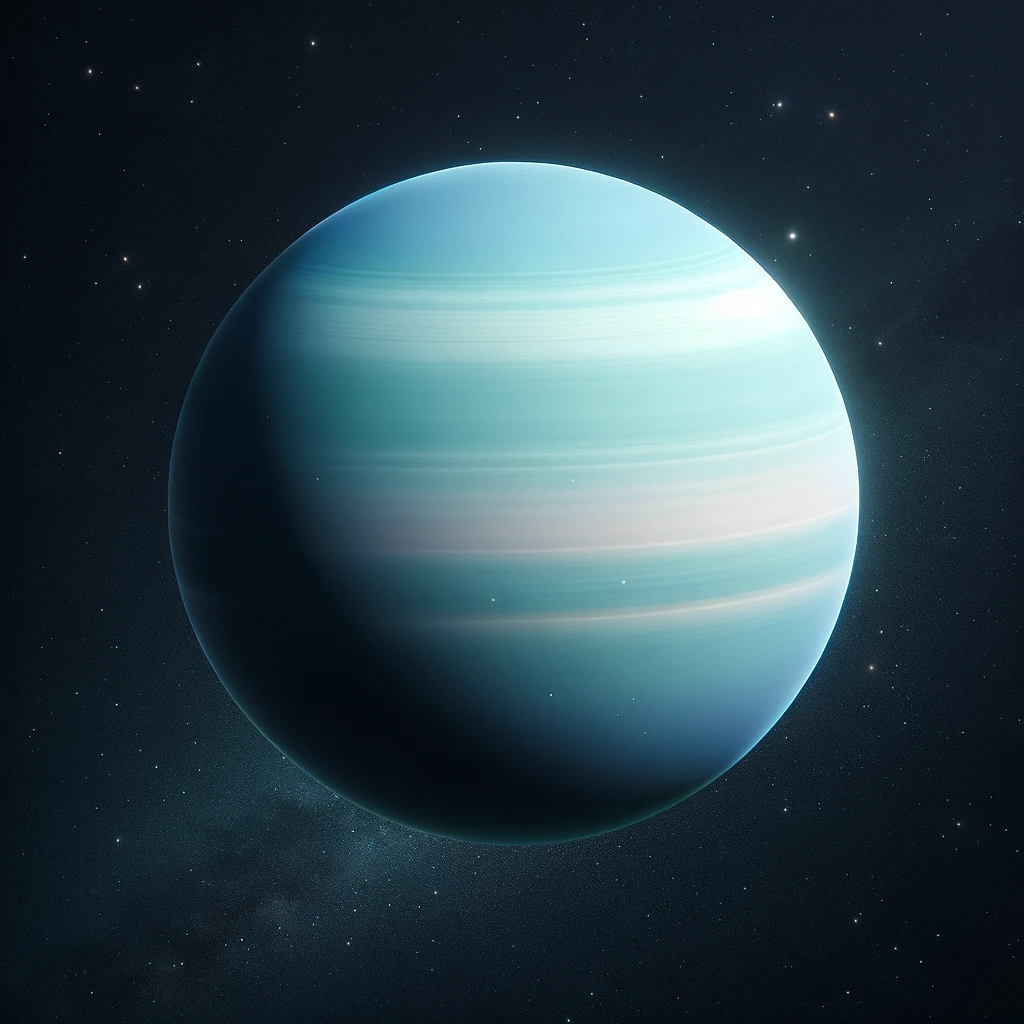Greetings, space adventurers! Captain Nova here, continuing our cosmic journey on Day 11 of “100 Days of Space Exploration.” Today, our voyage brings us to Uranus, the seventh planet from the Sun and one of the most mysterious and intriguing worlds in the Solar System. Often overlooked in favor of its flashier neighbors, Uranus has a unique story to tell. Let’s uncover the secrets of this ice giant together!

Uranus: Quick Facts
Before we dive into Uranus’ icy depths, let’s get acquainted with some quick facts:
- Diameter: 50,724 kilometers (31,518 miles), making it the third-largest planet in the Solar System.
- Distance from the Sun: Approximately 2.87 billion kilometers (1.78 billion miles).
- Day Length: 17.2 Earth hours.
- Year Length: 84 Earth years.
- Surface Temperature: A bone-chilling -224°C (-371°F), making it the coldest planet in the Solar System.
- Moons: 27 known moons, with intriguing names like Titania, Oberon, and Miranda.
- Rings: 13 known faint rings composed mostly of dark particles. These particles are likely composed of carbon-rich compounds, ice mixed with organic matter, and possibly radiation-darkened silicates. Their low albedo (reflectiveness) gives Uranus’s rings their faint and subtle appearance compared to the bright, icy rings of Saturn. This composition suggests that Uranus’s rings may be ancient and shaped by processes involving collisions and debris from shattered moons.
A Planet on Its Side
Perhaps Uranus’ most striking feature is its extreme axial tilt of 98 degrees. Unlike other planets, which spin more or less upright relative to their orbits, Uranus essentially rolls around the Sun on its side. This peculiar orientation results in seasons that last 21 Earth years each! Imagine living through decades of continuous daylight, followed by decades of darkness. Scientists believe this unusual tilt is the result of a colossal collision with an Earth-sized object during Uranus’ formative years.
The Composition of Uranus
Uranus is classified as an ice giant, distinguishing it from the gas giants, Jupiter and Saturn. Its unique composition provides valuable insights into planetary formation and the diversity of celestial bodies:
- Atmosphere: Composed mainly of hydrogen, helium, and methane, Uranus’ atmosphere is what gives it its distinctive blue-green color. Methane absorbs red light, leaving behind the serene hues we see.
- Mantle: Beneath the atmosphere lies a dense mantle of water, ammonia, and methane ices. This “icy” composition sets Uranus apart from its larger cousins.
- Core: At its heart, Uranus likely has a rocky core similar in size to Earth.
Rings and Moons: A Hidden Treasure
Though less prominent than Saturn’s, Uranus’ ring system is fascinating in its own right. The rings are dark and narrow, composed primarily of ice and rock particles. First discovered in 1977, they remain a focus of scientific study, revealing much about the planet’s gravitational dynamics and history.
Uranus’ moons are equally captivating. Let’s highlight a few of the most intriguing:
- Titania: The largest of Uranus’ moons, Titania boasts deep canyons and icy plains. Its surface suggests a history of tectonic activity, hinting at a dynamic past.
- Miranda: This small moon is a patchwork of cliffs, ridges, and grooves. Miranda’s surface appears to have been reshaped multiple times, possibly due to tidal forces.
- Ariel and Umbriel: These moons have cratered surfaces, with Ariel showing evidence of relatively recent geological activity.
The Mystery of Uranus’ Magnetic Field
Another unique aspect of Uranus is its magnetic field. Unlike Earth’s, which is closely aligned with its rotational axis, Uranus’ magnetic field is tilted by 59 degrees and offset from the planet’s center. This creates a lopsided and dynamic magnetosphere that interacts with the solar wind in fascinating ways, producing auroras unlike any seen on Earth.
The Voyager 2 Encounter
Our most detailed look at Uranus came from NASA’s Voyager 2 spacecraft, which flew by the planet in January 1986. During this brief encounter, Voyager 2 revealed:
- A wealth of information about Uranus’ atmosphere, magnetic field, and moons.
- The presence of 10 additional moons.
- Detailed images of Uranus’ faint rings.
Although the data gathered was invaluable, Voyager 2’s flyby left many questions unanswered, making Uranus a prime target for future missions.
Why Uranus Matters
Studying Uranus is crucial for understanding the diversity and evolution of planets both within and beyond our Solar System. Here’s why:
- Insights into Ice Giants: Uranus and its sibling Neptune represent a class of planets that are common in other star systems but rare in our own.
- Clues to Planetary Formation: Understanding Uranus’ structure and composition helps scientists piece together the processes that shaped our Solar System.
- Potential for Life: Some of Uranus’ moons, like Titania and Ariel, may harbor subsurface oceans, offering tantalizing possibilities for astrobiology.
Future Missions to Uranus
Excitingly, plans for a dedicated mission to Uranus are gaining traction. A proposed orbiter could provide detailed studies of its atmosphere, rings, and moons, answering longstanding questions and uncovering new mysteries. Such a mission would be a monumental step in exploring the outer reaches of our Solar System.
Uranus in Mythology and Culture
In Roman mythology, Uranus was the god of the sky, a fitting name for a planet shrouded in mystery and wonder. Uranus’ serene, icy appearance has inspired artists, writers, and dreamers, symbolizing the vastness of the cosmos and humanity’s unyielding curiosity.
A World of Icy Wonders
As I gaze at Uranus from the Odyssey Explorer, I’m struck by its tranquil beauty and the many secrets it holds. This ice giant reminds us that even the most distant and cold worlds are full of surprises and scientific treasures.
Tomorrow, we’ll journey to Neptune, the outermost planet in our Solar System, and explore its turbulent blue storms and fascinating features. Until then, keep your eyes on the stars and your minds open to the wonders of the universe.
Stay curious,
Captain Nova
Odyssey Explorer
Leave a Reply